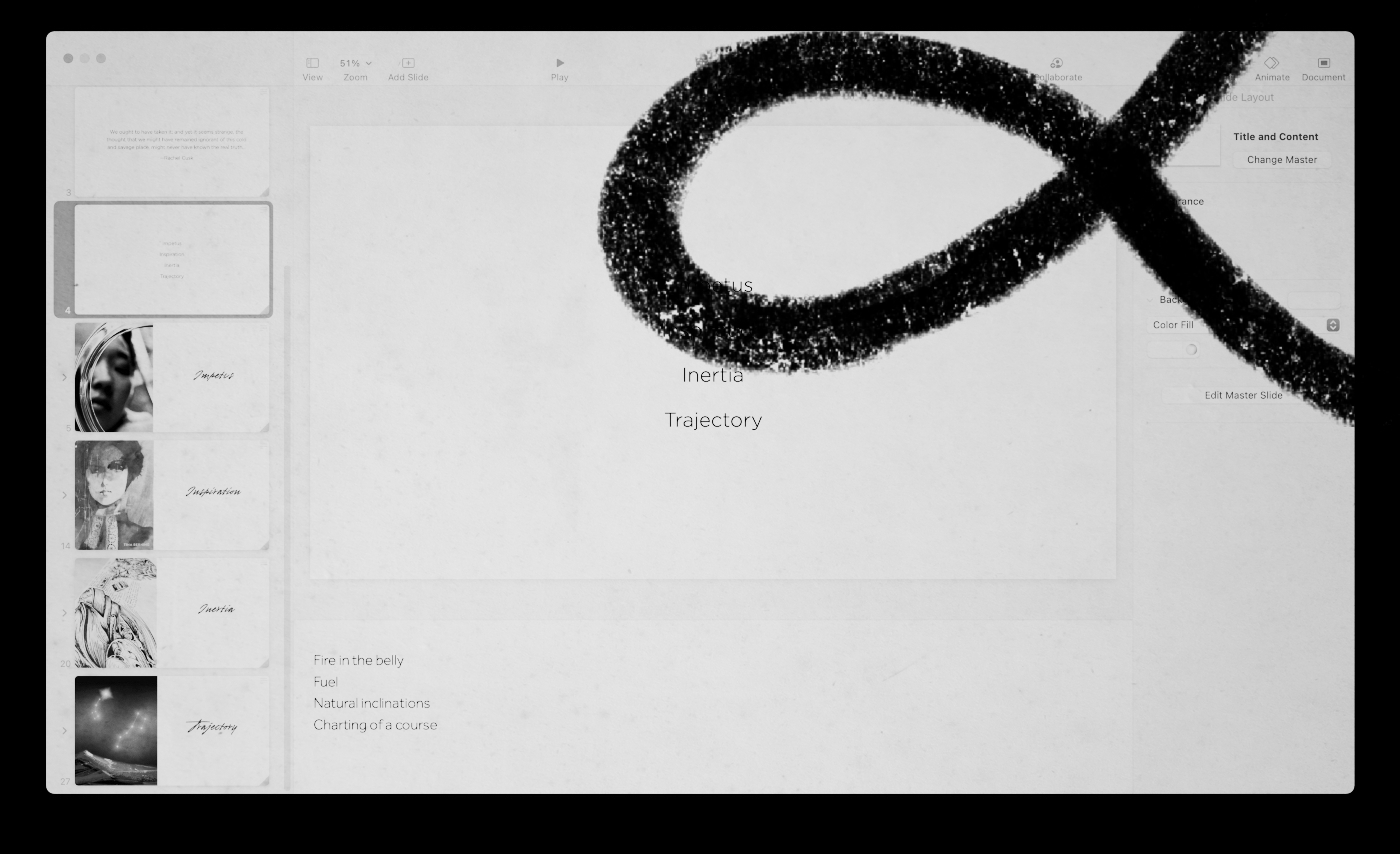
Hi! Dan here. How do you get unstuck on a project that you've left on the shelf for too long? It's so hard: you pick it up and you want so badly to start working on it again. But you can't quite bring yourself to get started because you don't even know how to begin. That's what today's essay from artist and designer Coleen Baik is all about. She teaches us how to make a "Whats' Next" deck—a collection of slides that can help you reestablish the context for your creative work, and pick up that project you’ve left on the shelf for so long. I hope you enjoy it!
When the pandemic hit NYC last March, I quietly set aside the animation I’d been working on. In fact, I all but stopped making art.
It was almost shocking how fluidly I went from 60 to 0 almost overnight. One day I was fully engaged in a fast and familiar routine. The next, I… just wasn’t. And I didn’t fight it. It felt natural, and yet inverse, somehow—like going back into the womb.
After the 2020 U.S. presidential elections and the rollout of the vaccines, I began to feel myself waking back up. There were small signals, like the tingling of nerves when a sleeping limb becomes sensate again: I found myself thinking about the animated short I had long set aside, wanting to finish it, put it out into the world, begin something else.
After almost a year of unplanned pause, this is the exercise I did to help me get back in the groove. What anchored it was a deck of slides, of all things—something that seems incredibly unpoetic and mundane for something so consequential and momentous.
And yet, I can’t emphasize enough how powerful and effective this work was in getting me re-oriented and back to speed. It helped me kick loose from a rut and jumpstart my next chapter.
I include a link at the end to a template in case you choose to explore something like this, yourself.
I began methodically with questions and provocations, owing perhaps to my decades-long career as a designer. I used Keynote to organize my thoughts, an app with which I explored product stories and created quick and dirty prototypes as a designer at Twitter many years ago. It’s a versatile tool with powerful transitional and bitmap-handling capabilities.
Slides force you to articulate thoughts in sequence, in the context of a narrative. It puts you into the mind-frame of connecting the dots for someone, of telling a story. A deck of slides must be clear, concise, and easy to follow in order to be effective. It’s ideal for communicating complex ideas.
At the same time, slides free you from the onus of up-front organization because they’re so easy to rearrange, reorder, and regroup. You can be pithy in the body while dumping longer thoughts into presenter notes to riff from. You can rely heavily on visuals.
1. Frame it
I like starting a deck with a quotation.
It helps set the stage and reminds me why I’m doing the exercise in the first place. Quotations are also great for addressing the ineffable and the emotional side of the “why.”
I ended up using an excerpt from The Last Supper by British writer Rachel Cusk. Given how careful I knew her to be with words, I was struck to find what initially read as a tautology (“real truth”). It led me to meditate on the idea of artistic integrity that felt deeply in accordance with the nature of this exercise.
2. Set an anchor
I wanted to address some big questions. What do I want to do now? How? Why? What does “success” look like?
First, though, I spent some time articulating why I wanted to do this exercise to begin with. That articulation put in place the beginnings of a structure to anchor myself (my point A) and set up expectations around outcome (my point B).
I knew that by the end, in addition to robust exploration of the big questions, what I wanted to end up with was a sort of future press release for myself as well as a synthesis of brainstorms and a loose plan for the year. The deck would serve as both a tactical as well as an aspirational primer. It would address the problem of what I perceived as drift; it would provide a compass and a direction.
3. Explore the map
In order to get a sense of how big the map was, I started out with a bunch of word and list dumps. I laid everything out on the table without regard for elegance or logic. The point was to see everything in one place, making evaluation more tractable.
Once I felt I’d gotten everything down (what I want to do, what I don’t want to do, what I already do, risks, challenges, motifs, modalities…), I started grouping them into sections:
Impetus
Reasons I want to tell the stories I want to tell, make the kind of art I want to make
Inspiration
What I find resonant and how it influences my direction
Inertia
What I already tend to do, what I enjoy doing, versus what I think I want to do
Trajectory
A flexible plan of short term executables plus longer-term aspirations
4. Impetus
This section was about impetus: the fire in the belly, the “Why.” Why I want to illustrate and animate, why I want to tell stories in this way over, say, being on stage, or by designing houses.
These ended up being about five slides. They speak to how much pleasure I derive from the physical act of drawing, for instance, how rich my experiences have been, how much I want to share them, how ideal I think they are for visualization and synchronization with sound.
It was particularly important for me to speak in as concrete and simple terms as possible here as well as be brutally honest. That made me feel confident about the foundation upon which I’d build the rest of the inquiry.
For better or worse, I focused on the pleasures: of process, resonance, self-centering…
5. Inspiration
The “Inspiration” section is largely a gathering exercise of what kind of art I like, practices, and people I’m inspired by.
Once I gathered the evidence, I ruminated on how I thought these influenced me. I held it up against what I thought I wanted to make going forward.
By the time I was done with this section it was easier for me to verbalize my aesthetic preferences, my stylistic leanings, the kind of a response I wanted to evoke in an audience, and why.
6. Inertia
They’re not mutually exclusive per se, but I’ve often confused ideals with what I actually want to do.
The Only Subscription
You Need to
Stay at the
Edge of AI
The essential toolkit for those shaping the future
"This might be the best value you
can get from an AI subscription."
- Jay S.
Join 100,000+ leaders, builders, and innovators

Email address
Already have an account? Sign in
What is included in a subscription?
Daily insights from AI pioneers + early access to powerful AI tools
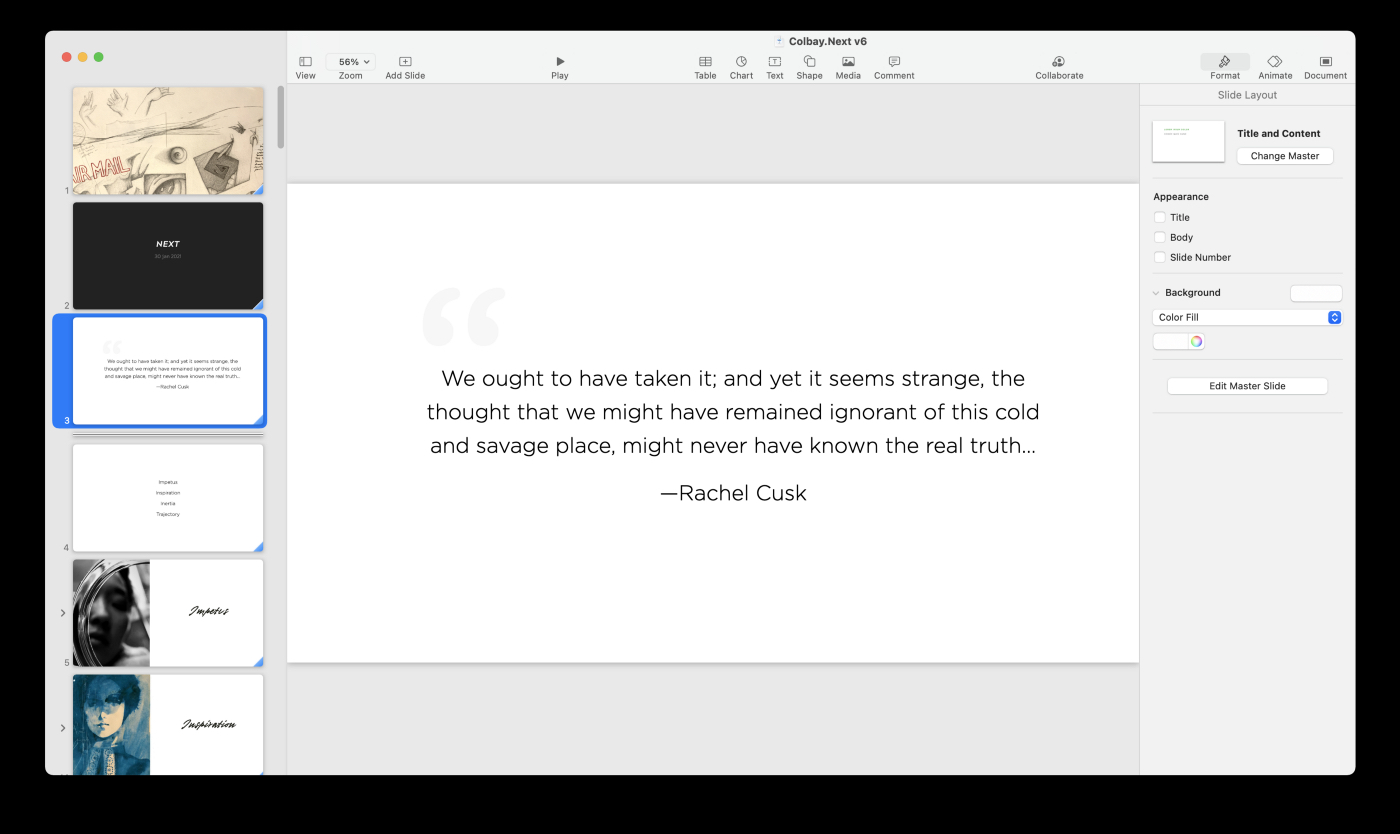
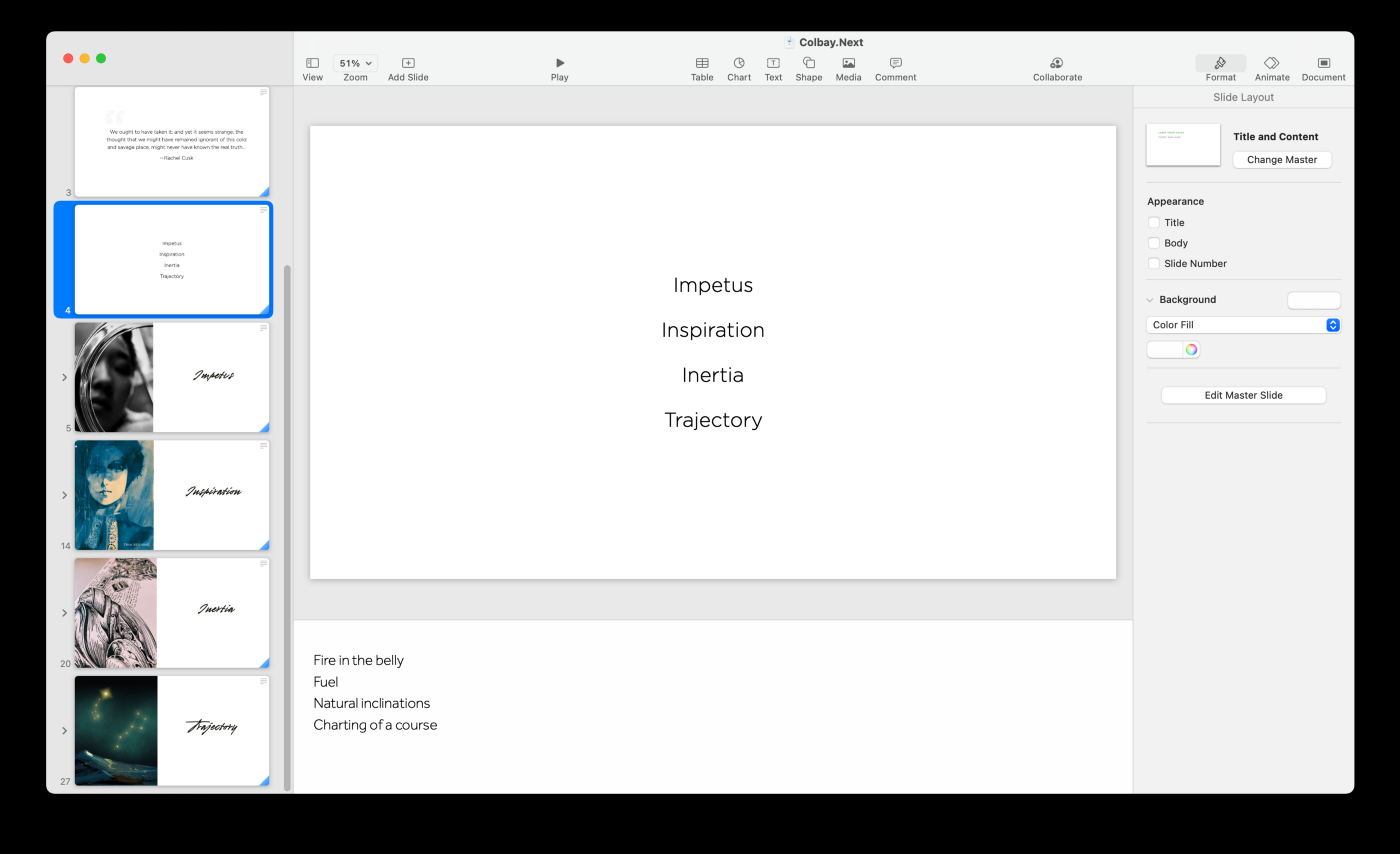

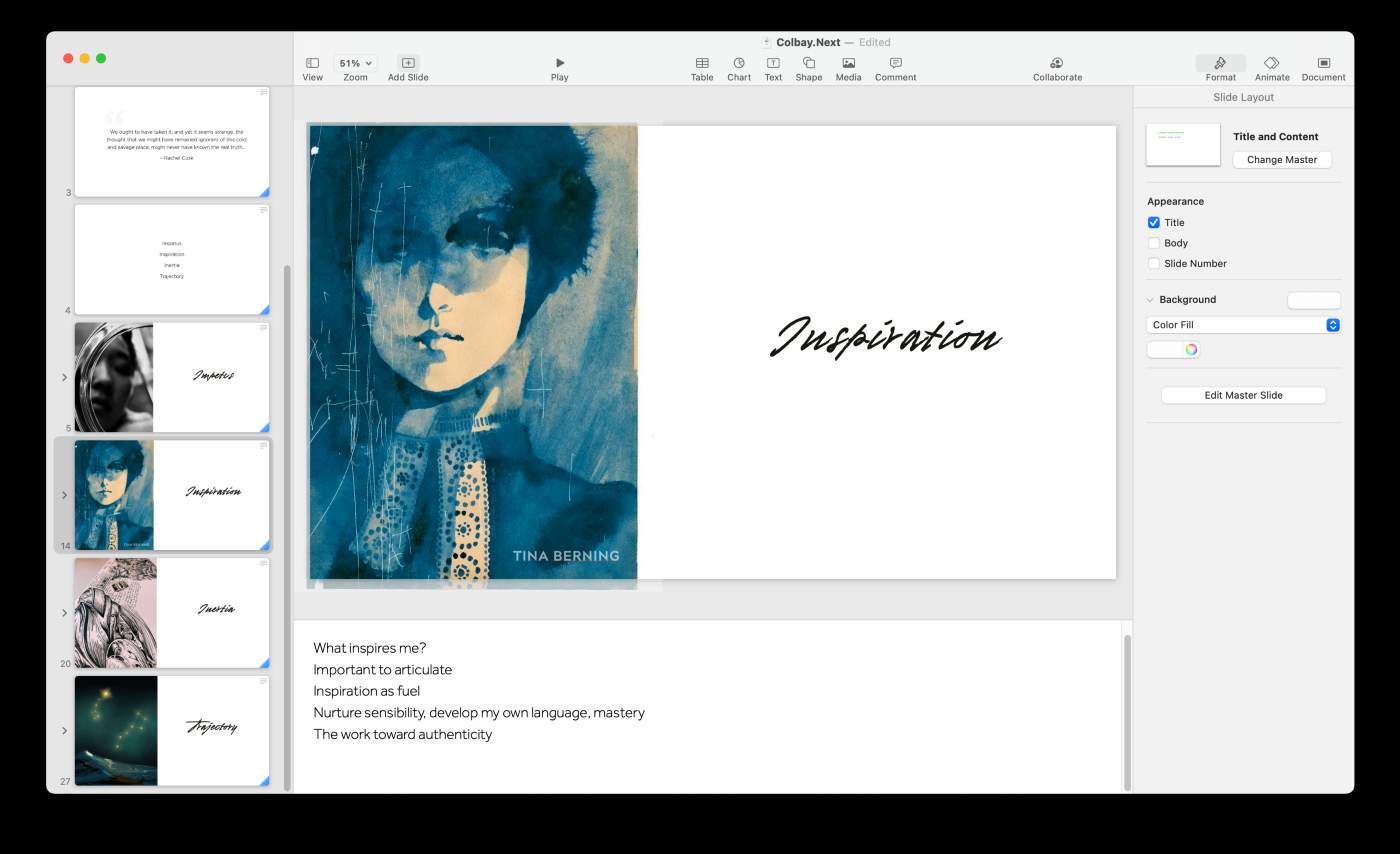








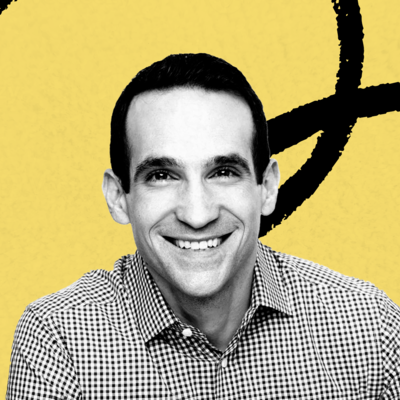



Comments
Don't have an account? Sign up!